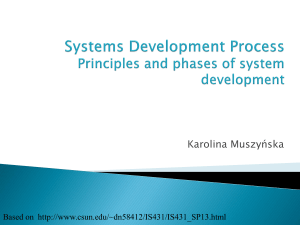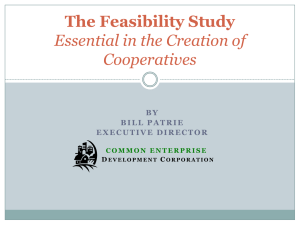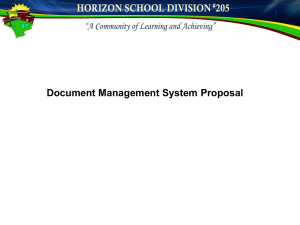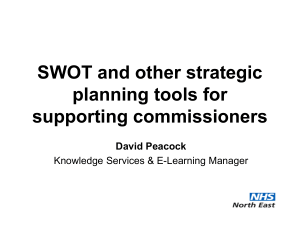Ch 5_1 Powerpoint
advertisement
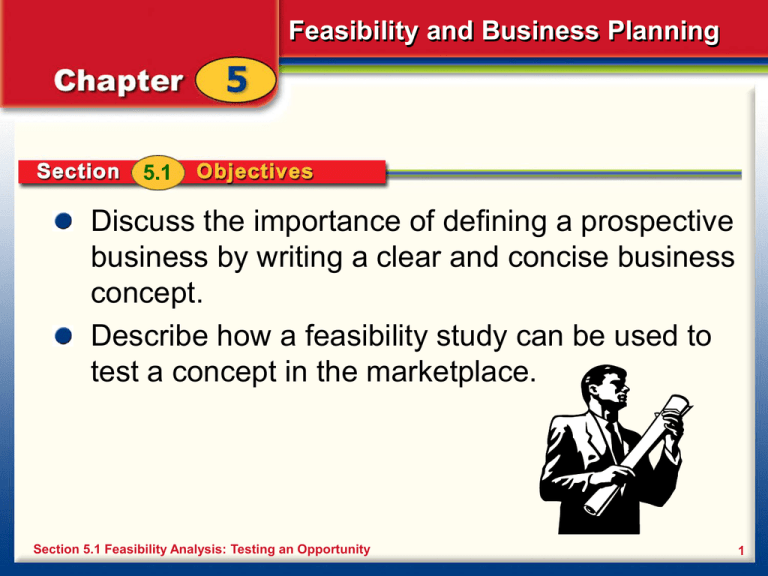
Feasibility and Business Planning 5.1 Discuss the importance of defining a prospective business by writing a clear and concise business concept. Describe how a feasibility study can be used to test a concept in the marketplace. Section 5.1 Feasibility Analysis: Testing an Opportunity 1 Feasibility and Business Planning Developing a Business Concept Once you have a idea for a new business, define it by writing a clear and concise business concept. Section 5.1 Feasibility Analysis: Testing an Opportunity business concept a clear and concise description of a business opportunity; it contains four elements: the product or service, the customer, the benefit, and the distribution 2 Feasibility and Business Planning Developing a Business Concept In developing a business concept, consider the features and benefits your product or service offers. features distinctive aspects, qualities, or characteristics of a product or service benefits things that promote or enhance the value of a product or a service to the customer Section 5.1 Feasibility Analysis: Testing an Opportunity 3 Feasibility and Business Planning Developing a Business Concept When developing a business concept an entrepreneur must ask the following questions: What is the product or service being offered Who is the customer? What is the benefit that is being provided? How will the benefit be delivered to the customer? Section 5.1 Feasibility Analysis: Testing an Opportunity 4 Feasibility and Business Planning Testing the Concept in the Market An entrepreneur can use a feasibility analysis in order to decide if there is enough demand for a product or service. feasibility analysis the process that tests a business concept; it allows the entrepreneur to decide whether a new business concept has potential Should I proceed with this business? Section 5.1 Feasibility Analysis: Testing an Opportunity 5 Feasibility and Business Planning Testing the Industry The broadest level of feasibility analysis looks at the industry in which the business will operate. Section 5.1 Feasibility Analysis: Testing an Opportunity industry a group of businesses with a common interest 6 Feasibility and Business Planning Testing Product or Service Requirements To consider all the requirements of a product or service, you may opt to create a prototype. Section 5.1 Feasibility Analysis: Testing an Opportunity prototype a working model used by entrepreneurs to determine what it takes to develop their products or services 7 Feasibility and Business Planning A business can analyze its: SWOT analysis An assessment of a company’s strengths and weaknesses and the opportunities and threats that surround it; SWOT: strengths, weaknesses, opportunities, threats. Strengths Weaknesses Opportunities Threats in the marketplace using a process called a SWOT analysis. This procedure helps because it: • prepares a company for competition or a changing marketplace. • provides guidance and direction for future business strategies. 8 Feasibility and Business Planning Internal Strengths and Weaknesses Strengths and weaknesses are internal factors that affect a business operation. The analysis centers around three Cs: •Company •Customers •Competition 9 Feasibility and Business Planning Internal Strengths and Weaknesses • Company When evaluating itself, a company must analyze these areas: •Company staff •Financial situation •Production capabilities 10 Feasibility and Business Planning Talking to Customers • Customers The most important part of the feasibility analysis is testing customers to measure interest and identify the target customers. Companies study customer buying patterns using surveys or conducting interviews with people in their target markets. Section 5.1 Feasibility Analysis: Testing an Opportunity target customers people most likely to buy a business’s products and services 11 Feasibility and Business Planning Studying the Competition • Competition A company may find that it has certain strengths and weaknesses when compared to its competitors. Questions that help a business to analyze its competitive position are: • What market share does the company have? • What advantages does the company have over its competitors? • What core competencies does the company possess? 12 Feasibility and Business Planning Studying the Competition An easy way to evaluate the competition is to create a competitive grid. Competitor Customer Benefits Distribution Strengths Section 5.1 Feasibility Analysis: Testing an Opportunity competitive grid a tool for organizing important information about a business venture’s competition Weakness 13 Feasibility and Business Planning External Opportunities and Threats Businesses must always look for opportunities to create competitive advantage if they are to succeed in the marketplace. Marketing Essentials Chapter 2, Section 2.1 14 Feasibility and Business Planning Competition Companies need to know what their competitors are doing at all times. Changes in other companies’ financial situations affect the marketplace, and conducting a SWOT analysis helps a business react and adjust to these shifts. 15 Feasibility and Business Planning environmental scan An analysis of outside influences that may have an impact on an organization. Environmental Scan Often, a business will conduct an environmental scan to methodically examine four main areas of the marketplace. The acronym PEST refers to each of the four factors evaluated in the scan: • Political • Economic • Socio-cultural • Technological 16 Feasibility and Business Planning Political Political issues center around government involvement in business operations, such as: • Laws • Regulations Global companies need to know the political structure and regulations of each foreign country in which they conduct business. 17 Feasibility and Business Planning Economic Businesses are always interested in the economy because if it is healthy, people will be more likely to invest in products and markets. If the economy is in recession, companies need to be more cautious in their decisions. The economy is affected by factors such as: • Unemployment rate • Inflation • Retail sales figures • Productivity • Consumer confidence 18 Feasibility and Business Planning Socio-Cultural A socio-cultural analysis is based on customers and potential customers. It focuses on their: • Attitudes • Lifestyles • Opinions And also considers: • Age • Income • Occupation • Education level • Marital status 19 Feasibility and Business Planning Technological Changing technology may be a threat for one industry, but an opportunity for others. Companies develop completely new products or capitalize on new developments by making products to support them. 20 Feasibility and Business Planning Looking at Start-Up Resources A strong business model is important to investors. Section 5.1 Feasibility Analysis: Testing an Opportunity business model a description of how entrepreneurs plan to make money with their business concepts 21 Feasibility and Business Planning Let’s Practice Write a compelling, clear & concise business concept statement for your proposed business. Be sure to refer back to your notes on questions to address. Here is a sample of one: “Eastside Sports offers sporting equipment and apparel to local teams and people who play sports. It provides the convenience of one-stop shopping at a retail outlet in the customer’s own neighborhood.” 22


